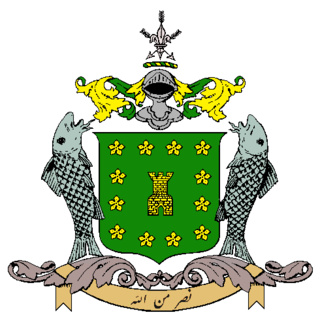
Badakhshan is a historical region comprising parts of what is now north-eastern Afghanistan, eastern Tajikistan, and the Tashkurgan county in China. The name is retained in Badakhshan Province, which is one of the 34 provinces of Afghanistan and is located in Northeastern Afghanistan. Much of historic Badakhshan lies within Tajikistan's Gorno-Badakhshan Autonomous Region, located in the southeastern part of the country. The music of Badakhshan is an important part of the region's cultural heritage.

The Chagatai Khanate, or Chagatai Ulus, was a Mongol and later Turkicized khanate that comprised the lands ruled by Chagatai Khan, second son of Genghis Khan and his descendants and successors. At its height in the late 13th century, the khanate extended from the Amu Darya south of the Aral Sea to the Altai Mountains in the border of modern-day Mongolia and China, roughly corresponding to the defunct Qara Khitai Empire.
Ahmad Khan was a sultan of the Principality of Herat in Afghanistan. He ruled from September 1857 to April 1863. He was a nephew of Dost Mohammad Khan. In 1855-56, Sultan Ahmad Khan sent a petition to the Shahanshah. If they would support Sultan Ahmad Khan with an army he would overthrow the Amir-i Kabir and annex Afghanistan into the Guarded Domains. He was intercepted by Dost Mohammad Khan though and exiled Sultan Ahmad Khan to Iran. When the Anglo-Persian War ended he was installed as ruler of Herat by the Iranians, as they evacuated Herat in September 1857 in accordance with the Treaty of Paris. During his reign, he was completely dependent on Iran and not only minted coins in the Shahanshah's name, but also repeatedly given support upon request against the Mohammadzais. Naser al-Din Shah bestowed the title of Sirkar on Sultan Ahmad Khan and bestowed the title of Amir Panji on Sultan Ahmad Khan's son, Shah Nawaz Khan.
The names of people, battles, and places need to be spelled as they are on other articles title and then wikified.
This is a timeline of major events in the Muslim world from 1400 AD to 1499 AD.

The Nawabs of Bhopal were the Muslim rulers of Bhopal, now part of Madhya Pradesh, India. The nawabs first ruled under the Mughal Empire from 1707 to 1737, under the Maratha Empire from 1737 to 1818, then under British rule from 1818 to 1947, and independently thereafter until it was acceded to the Union of India in 1949. The female nawabs of Bhopal held the title Nawab Begum of Bhopal.
Ahmad Alaq was the Khan of Eastern Moghulistan (Uyghurstan) from 1487 to 1503. He was the second son of Yunus Khan. His mother was Shah Begum, fourth daughter of Badakhshan prince Lali.
Dost Muhammad Khan was Khan of Aqsu in Moghulistan from 1462 until his death. He was the son of Esen Buqa II.

Esen Buqa II was Khan of Moghulistan from 1429 until his death. He was the younger son of Uwais Khan.

Yunus Khan, was Khan of Moghulistan from 1462 until his death in 1487. He is identified by many historians with Ḥājjī `Ali, of the contemporary Chinese records. He was the maternal grandfather of Babur, founder of the Mughal Empire.
Sultan Mahmud Khan, was Khan of Tashkent and of the Moghuls of western Moghulistan (1487–1508). He was the eldest son of Yunus Khan. He was born in 1462, his mother was Shah Begum, daughter of Badakhshan prince Lali, who claimed his descent from Alexander the Great and gave one of his six daughters to Yunus Khan in marriage, pleasing his request.

Moghulistan, also called the Eastern Chagatai Khanate, was a Mongol breakaway khanate of the Chagatai Khanate and a historical geographic area north of the Tengri Tagh mountain range, on the border of Central Asia and East Asia. That area today includes parts of Kazakhstan, Kyrgyzstan, and northwest Xinjiang, China. The khanate nominally ruled over the area from the mid-14th century until the late 17th century, although it is debated whether it was a continuation of the Chagatai Khanate, an independent khanate, or a tributary state to the Ming dynasty.
Sultan Said Khan ruled the Yarkent Khanate from September, 1514, to July, 1533. He was born in 1487 in Moghulistan and was a direct descendant of the first Moghul Khan, Tughlugh Timur, who had founded the state of Moghulistan in 1348 and ruled until 1363. The Moghuls were turkicized Mongols who had converted to Islam.
Saniz Mirza was the Dughlat amir of Yarkand from 1457/58 until his death. He was the elder of two sons of Amir Sayyid Ali.
Muhammad Haidar Mirza was the Dughlat amir of Kashgar from c. 1465 until 1480. He was the grandfather and namesake of the historian Muhammad Haidar Mirza (1499/1500-1551).

In the early 16th century, Sultan Mahmud Khan, the Chagatai Khan of Western Moghulistan, and Sultan Ahmad Alaq Khan, the Chagatai Khan of Eastern Moghulistan, decided to counter the growing power of the Uzbeks under Muhammad Shaybani. Sultan Ahmed Tambol had rebelled against his Timurid master Babur and declared his independence. But when Babur tried to reconquer his territory with the help of his uncles, Ahmed Tambol sought the assistance of the Uzbeks. The two Moghul brothers united their forces and launched a campaign against Tambol, but Muhammad Shaybani surprised the Khans and proved victorious in battle of Akhsi and took them both prisoner.

Aisan Daulat Begum was the Queen consort of Moghulistan as the first wife and chief consort of Yunus Khan, a descendant of Chaghatai Khan, the second son of Genghis Khan. She was the mother of Qutlugh Nigar Khanum, and hence the grandmother of the first Mughal emperor, Babur.
Shah Begum was the Queen consort of Moghulistan as the second wife of Yunus Khan, a descendant of Chaghatai Khan, the second son of Genghis Khan. She was the mother of Mahmud Khan and Ahmad Alaq, the next Moghul Khans of Moghulistan.
Sultan Mohammad Khan, also known as "Sultan Muhammad Khan Telai" was an Afghan Aristocrat, Chief Minister and regent, who resigned in favor of his younger brother Amir Dost Mohammad Khan. Dost Muhammad Khan derisively called Sultan Mohammed Khan, "Sultan Bibi", meaning "lady". His other brother was Fateh Khan, who died in 1818. During the reign of his brother he was chief minister and governor of various regions of the Emirate. He was the first Musahiban, an ethnic Pashtun, and the 15th son of Sardar Payendah Khan who was killed in 1799 by Zaman Shah Durrani. Sultan Muhammad Khan's grandfather was Hajji Jamal Khan. His immense love for materialism, like clothes and golden cutlery led to his family giving him his nickname "Telai", meaning golden. The result was amongst other things no progress and social injustice. These cases of power abuses were well known in the Afghan monarchy, even during the regency of Sultan Muhammad Khan's descendants of the Musahiban branch.





